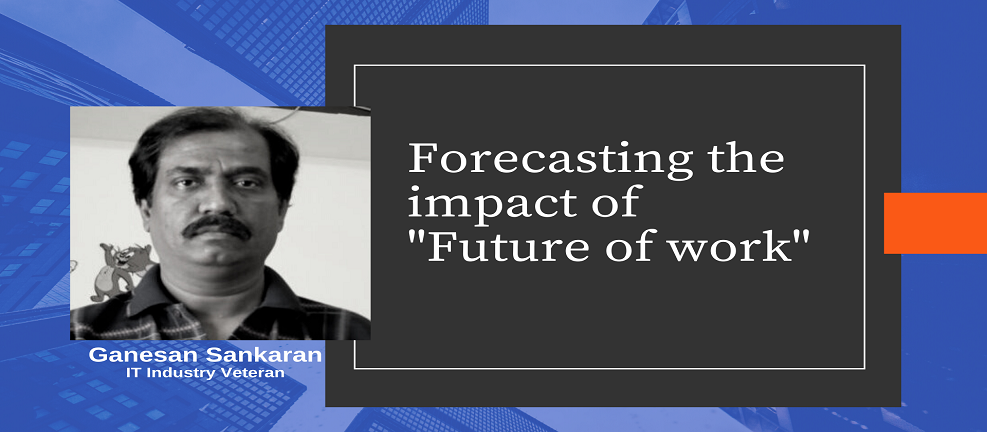Interview with Ganesan Sankaran: Insights from a Veteran CIO

Ganesan Sankaran, an IT industry veteran with over 35 years of experience, has worked with leading organizations such as Ramco Systems, Hexaware, Satyam Computers, HP Global Soft, and currently heads IT for Star Health and Allied Insurance Co. Ltd., a major health insurance company in India. His illustrious career reflects the evolution of IT in India and how technology has reshaped the industry.
The AiDOOS team had the privilege of interviewing him to delve into his career journey, achievements, and predictions for how technology will redefine the future of work. Below are excerpts from the interview.
Q: Can you share your experience with computer education and technology during your formative years?
Ganesan: Ours was the first MCA batch from Regional Engineering College (REC), Trichy, in 1984, marking a significant milestone as MCA was introduced in India that year. At that time, computers were largely unknown—most of us, including myself, saw a computer for the first time after joining college. These were simple dumb terminals without any built-in intelligence, relying entirely on backend servers.
Programming was done in languages like BASIC, FORTRAN, COBOL, and PASCAL, and there were no debugging tools. Writing, compiling, and debugging programs was an incredibly meticulous process that tested one’s patience and skills.
Q: What influenced your decision to pursue computer education?
Ganesan: My background in mathematics and logic naturally led me to pursue MCA when it was introduced. It seemed like a professional course with immense potential for career growth, blending creativity with problem-solving.
Q: Can you highlight some key moments in your career journey?
Ganesan: After my initial years in software development, I joined Ramco Systems, where I worked on building an ERP product for the international market. It was one of the first ERPs developed in India, competing with global giants like Oracle. This 10-year stint was the most fulfilling phase of my career, allowing me to innovate, build reusable components, and deliver generic solutions to diverse customers.
Later, I transitioned to Hexaware, Satyam Computers, and HP Global Soft, working on services for global clients, particularly in the U.S. Currently, at Star Health Insurance, I am leveraging my consulting experience to make informed technology decisions and streamline vendor management.
Q: What would you have done differently with today’s technologies?
Ganesan: Back then, the lack of GUI tools and internet access required us to be highly creative in solving problems. With today’s advanced tools and readily available information, we could have focused more on addressing complex business challenges rather than overcoming technological limitations.
Q: How is technology shaping operations at Star Health Insurance?
Ganesan: We are pioneers in the private healthcare sector and have been investing heavily in digital transformation and automation. Our focus is on enhancing customer experience, migrating applications to the cloud, and leveraging AI/ML technologies to improve processes. These investments are helping us stay ahead of the competition and deliver superior value to our customers.
Q: What is your vision for the future of work?
Ganesan: Work habits are changing significantly. With advancements in technology and connectivity, a large portion of work can be done remotely. Distributed teams across geographies are becoming the norm. Remote working not only improves productivity but also helps employees achieve better work-life balance.
The future of work will be driven by clear task definitions, robust collaboration tools, and outcome-based evaluations. This shift will save organizations costs on infrastructure while enabling them to tap into a global talent pool.
Q: How do you see startups and niche players disrupting the IT service industry?
Ganesan: Disruption is already underway. Smaller, focused players are eating into the market share of large IT service providers. These companies deliver faster turnarounds and high-quality services. We’ve already started working with such niche players who provide specialized expertise and personalized attention, which large vendors often cannot match.
Q: What are your thoughts on the AiDOOS platform and its on-demand expertise model?
Ganesan: The on-demand service model is a game-changer. Platforms like AiDOOS are disrupting traditional IT services by offering pay-as-you-go expertise. This model aligns well with current business needs, particularly for IT maintenance and legacy system support, where finding the right expertise is challenging.
If AiDOOS can isolate use cases that don’t compromise IP or data security, it can address a critical gap in the industry. Many organizations struggle to maintain legacy systems due to a lack of experienced professionals. AiDOOS’ ability to provide expertise on-demand can bridge this gap effectively.
Ganesan Sankaran’s career reflects the evolution of the IT industry in India, from its nascent stages to the highly advanced, interconnected ecosystem of today. His insights into leveraging technology for transformation and his emphasis on adapting to disruptions underscore the importance of staying ahead of the curve.
Platforms like AiDOOS Virtual Delivery Centers (VDCs) have the potential to redefine IT service delivery by combining on-demand expertise with cost efficiency and quality assurance. As Ganesan rightly points out, the future belongs to organizations that embrace change, adopt disruptive technologies, and leverage innovative models like AiDOOS.
Explore AiDOOS Virtual Delivery Centers (VDCs) and transform your IT service strategy![]()

For modern telecom enterprises, delivering exceptional QoS is no longer optional—it’s a brand differentiator and a strategic lever for growth. Static provisioning models won’t cut it in a world of hyper-dynamic data usage.